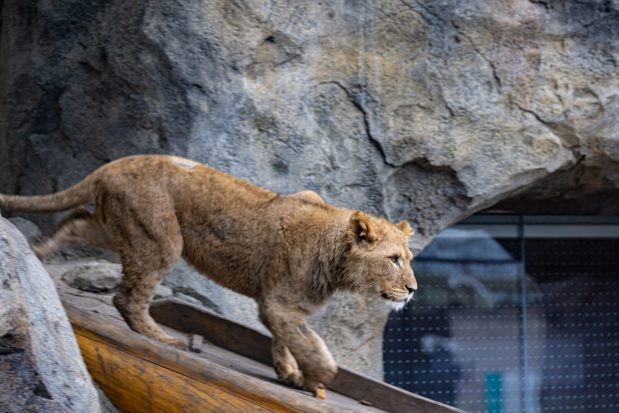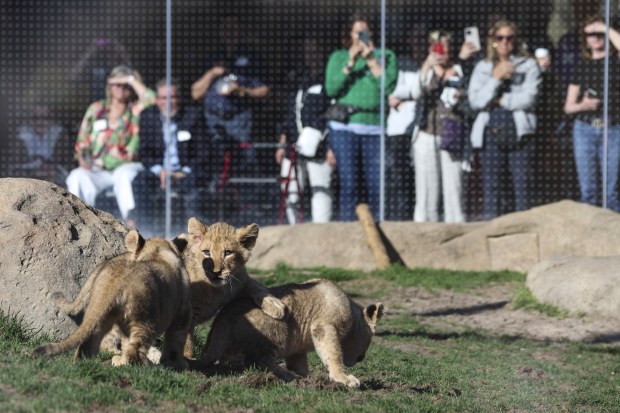A 17-month-old African lion cub at the Lincoln Park Zoo, known for his sweet and laid-back personality that captured the hearts of thousands in Chicago and on social media, has died following a slow recovery from a spinal surgery.
Lomelok was born with a spinal defect that’s caused mobility challenges since he was a few weeks old, zoo officials said. He had an operation in March — the first of its kind on a lion cub — to reduce his pain and treat a herniated disc.
Lomelok’s recovery from the surgery was “slow and steady,” officials said, but he wasn’t “thriving” as he should. When veterinary staff detected a gastrointestinal obstruction that would have required another intensive surgery and a lengthy recovery, they made the “difficult but responsible decision” to euthanize Lomelok on Saturday.
“We have been overwhelmed by the support from the community for Lomelok throughout his health journey,” said Cassy Kutilek, the curator of mammals, in a Monday news release. “Lomelok’s name means ‘sweet’ in the Maa language, and that was the best way to describe him. There are no words to articulate how deeply he will be missed.”
Lomelok, who was roughly 2 pounds at birth, grew to more than 250 pounds. Zoo officials said he had started growing a thick adolescent mane. One of his favorite activities, officials said, was laying upside down and showing his white belly fur. His care team is “still processing this incredibly tough loss,” a zoo spokesperson said.
Lomelok and his two brothers, Pesho and Sidai, were born Jan. 9, 2023, at the Pepper Family Wildlife Center. His mother, Zari, gave birth after five hours of labor, earning her the title of “rock star” among zoo staff.
Lomelok’s family also included his older brother, Pilipili, his father, Jabari, and aunts Hasira and Cleo. Both of Zari’s pregnancies were part of the African Lions Species Survival Plan, a population management effort across accredited zoos within the Association of Zoos and Aquariums.
Zari “immediately attended to the cubs, started grooming them, and then, within hours of their birth, she started nursing them and feeding them,” the zoo’s curator of mammals and behavioral husbandry Mike Murray told the Tribune after the three cubs’ birth.
After some private time with little human intervention, the cubs made their public debut in April 2023, with much fanfare. Pictures and videos of Lomelok’s young life, from his birth to his first playful steps in a new home to his antics with a tree, circulated across the internet.
Three lion cubs make their debut at the Pepper Family Wildlife Center on April 14, 2023, at the Lincoln Park Zoo in Chicago.
When Lomelok started to grow, staff were concerned about his rear limbs and lower-than-normal activity levels. He was eventually diagnosed with stenosis, which zoo officials said is the narrowing of channels that carry nerves from the spine to the legs.
“You can think of the spinal cord as a highway, carrying nerve signals from your brain out to the rest of your body,” Lomelok’s veterinarian Dr. Kate Gustavsen said in March. “Between every set of vertebrae, there are exits that the nerves leave from.”
“In Lomelok’s case, the last two exits all the way at the end of the highway have a lane closed in each direction — they’re too narrow, everybody’s irritated, the traffic is moving slowly,” she continued. “That’s causing what we see physically as his muscles not developing completely appropriately and him being clumsy in his gate, and it also causes some discomfort.”
Spinal conditions in the wild
In the wild, it’s unlikely that Lomelok would have survived very long with this condition, according to Craig Packer, a professor at the University of Minnesota and director of the Lion Research Center.
When a lion is small, its mother carries it in its mouth with its teeth around its nape. But as the cub ages, the mother would have stopped carrying it, he said. Packer estimated that Lomelok had at least an extra year of life because of his care in captivity.
“That cub would have been left behind. That cub would have either starved to death or been killed by a leopard or hyena or another lion from a neighboring pride,” Packer said. “So that animal had a much longer life than you ever would have seen in the wild.”

The challenges of surviving with this condition in the wild make it hard to know how common spinal birth defects are in lions, Packer said. Mothers keep their cubs hidden for the first few weeks of their lives, and he said some research suggests they will abandon one member of their litter.
“I’m not saying they are deliberately leaving behind disabled cubs, but I can’t say that’s impossible,” he said. “We have some evidence that they don’t always keep every single one of their cubs.”
The opportunity to see Lomelok, or any lion cub, in a zoo is a fairly rare treat because zoos have to carefully control breeding, Packer said.
“If you had a female lion who had the maximum number of surviving cubs, which would be four, and they can start breeding especially in captivity by the time they’re just a little over 2 years old, after about 37 years, the descendants would need to eat the population of Chicago every week,” Packer said.
“You can’t let them breed at their maximum, so it’s a special thing in captivity,” he added.




